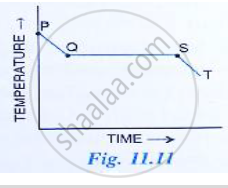Advertisements
Advertisements
Question
The process of converting a substance from gaseous state to solid state is called _______.
Solution
The process of converting a substance from gaseous state to solid state is called deposition.
APPEARS IN
RELATED QUESTIONS
How is the transference of heat energy by radiation prevented in a calorimeter?
What is the other name given to the principle of the mixtures?
What is the principle of Calorimetry?
Differentiate between heat and temperature.
1.0 kg of water is contained in a 1.25 kW kettle. Calculate the time taken for the temperature of water to rise from 25° C to its boiling point of 100°C. Specific heat capacity of water = 4.2 J g-1K-1.
Fig 11. 11 shows the variation in temperature with time when some wax cools from the liquid phase to the solid phase.
(i) In which part of the curve, the wax is in liquid phase?
(ii) What does the part QS of the curve represent?
(iii) In which part of the curve, the wax will be the in the liquid as well as solid phase?
(iv) In which part of the curve, the wax is in solid phase?

The melting point of naphthalene is 80°C and the room temperature is 30°C. A sample of liquid naphthalene at 100°C is cooled down to the room temperature. Draw a temperature time graph to represent this cooling. In the graph, mark the region which corresponds to the freezing process.
100 g of ice at -10°C is heated. It is converted into steam. Calculate the quantity of heat which it has consumed. (Sp. heat of ice = 2100J/kg°C, sp. heat of water= 4200 J/kgK, sp. heat of water = 42000 J/kgK, sp. latent heat of ice = 2260000 J/kg).
What mass of ice at 0°C will be required to cool 0.9 kg of water from 35°C to 0°C? Assume all the ice used melts. The specific heat capacity of water is 4.2 x 103 J/kgoC and specific latent heat of fusion of ice is 336 x 103 J/kg.
Fill in the following blank using suitable word:
Whenever mechanical work is done, .......... Is produced.
